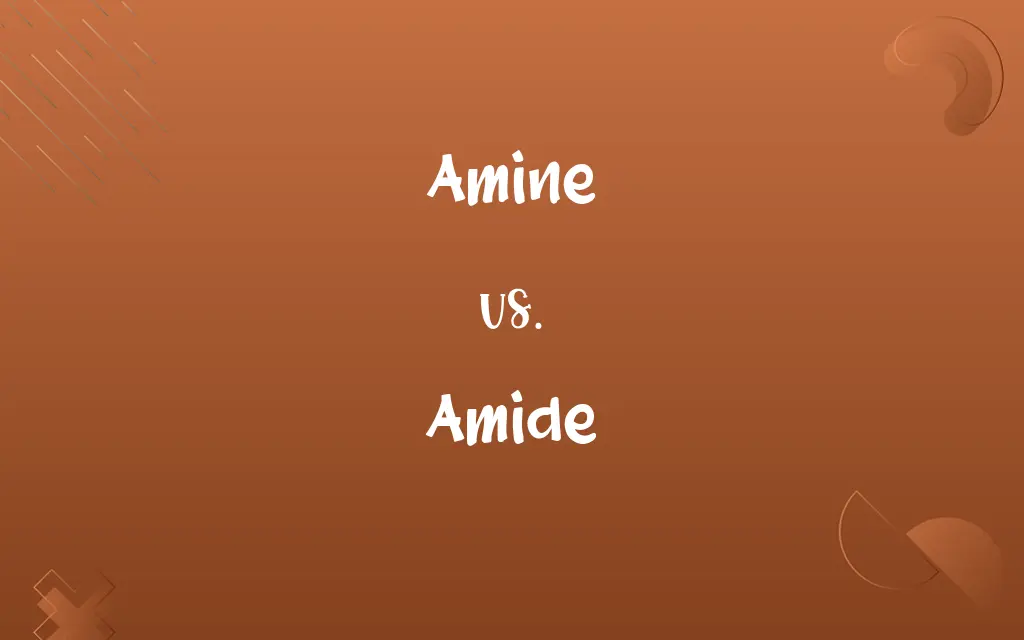Amine vs. Amide: Know the Difference

By Shumaila Saeed || Published on January 12, 2024
Amine is an organic compound derived from ammonia; amide is a compound where an amine group is bonded to a carbonyl group in an organic molecule.

Key Differences
Amines are organic compounds characterized by the presence of one or more nitrogen atoms bonded to carbon atoms. These compounds are derivatives of ammonia where one or more hydrogen atoms are replaced by organic groups. Amides, on the other hand, are organic compounds containing a carbonyl group (C=O) linked to a nitrogen atom. They are formed from a carboxylic acid and an amine or ammonia, where the carbonyl group of the acid reacts with the nitrogen atom of the amine.
Shumaila Saeed
Jan 12, 2024
In terms of structure, amines can be primary, secondary, or tertiary, depending on the number of organic groups attached to the nitrogen atom. Primary amines have one, secondary amines two, and tertiary amines three organic groups attached. Amides, however, are classified based on the number of substituents on the nitrogen atom, leading to primary, secondary, or tertiary amides, reflecting the nature of the substituents rather than the number of nitrogen attachments.
Shumaila Saeed
Jan 12, 2024
Amines typically have a fishy odor and are found in various biological systems, playing a crucial role in amino acids and neurotransmitters. They exhibit basic properties due to the lone pair of electrons on the nitrogen atom. Amides, while also containing a nitrogen atom, are less basic than amines due to the delocalization of the lone pair of electrons into the carbonyl group, making them more stable and less reactive.
Shumaila Saeed
Jan 12, 2024
The physical properties of amines vary; lower molecular weight amines are gaseous or liquid at room temperature, while higher molecular weight amines are solid. Amides are generally solid at room temperature, and their melting and boiling points are typically higher than those of corresponding amines due to the presence of stronger intermolecular forces, such as hydrogen bonding.
Shumaila Saeed
Jan 12, 2024
In practical applications, amines are widely used in the production of pharmaceuticals, dyes, and polymers. They are also important in agricultural chemicals like pesticides. Amides, with their greater stability, find extensive use in the manufacture of plastics, adhesives, and the synthesis of various organic compounds, showcasing the diverse applications of these nitrogen-containing organic compounds.
Shumaila Saeed
Jan 12, 2024
ADVERTISEMENT
Comparison Chart
Basic Structure
Nitrogen atom bonded to carbon atoms
Carbonyl group (C=O) linked to nitrogen atom
Shumaila Saeed
Jan 12, 2024
Classification
Primary, secondary, tertiary (based on attached organic groups)
Primary, secondary, tertiary (based on substituents on nitrogen)
Shumaila Saeed
Jan 12, 2024
Physical State
Gaseous, liquid, or solid (depending on molecular weight)
Generally solid at room temperature
Shumaila Saeed
Jan 12, 2024
Applications
Pharmaceuticals, dyes, polymers, pesticides
Plastics, adhesives, organic synthesis
Shumaila Saeed
Jan 12, 2024
ADVERTISEMENT
Amine and Amide Definitions
Amine
An amine is an organic compound with a nitrogen atom bonded to alkyl or aryl groups.
Methylamine, a simple amine, is used in the synthesis of pesticides.
Shumaila Saeed
Dec 16, 2023
Amide
An amide is an organic compound where a nitrogen atom is bonded to a carbonyl group.
Acetamide is used in organic synthesis and as a plasticizer.
Shumaila Saeed
Dec 16, 2023
Amine
Amines are characterized by their nitrogen content and are classified based on the number of organic groups attached.
Dimethylamine, a secondary amine, is used in the production of various chemicals.
Shumaila Saeed
Dec 16, 2023
Amide
Amides are less reactive than amines due to the delocalization of the nitrogen's lone pair.
Urea, an amide, is widely used as a fertilizer and a feed supplement.
Shumaila Saeed
Dec 16, 2023
Amine
Amines are used in the manufacture of dyes, drugs, and polymers.
Aniline, an aromatic amine, is a precursor in dye manufacturing.
Shumaila Saeed
Dec 16, 2023
ADVERTISEMENT
Amide
Amides have higher melting and boiling points compared to amines.
Benzamide, used in organic synthesis, has a high melting point.
Shumaila Saeed
Dec 16, 2023
Amine
Amines are derivatives of ammonia with one or more hydrogen atoms replaced by organic groups.
Ethylamine is found in natural processes and industrial applications.
Shumaila Saeed
Dec 16, 2023
Amide
Amides are formed from the reaction of carboxylic acids and amines or ammonia.
Nylon, a synthetic polymer, is a type of polyamide.
Shumaila Saeed
Dec 16, 2023
Amine
Amines exhibit basic properties and are integral in biological systems.
Dopamine, a neurotransmitter, is a type of bioactive amine.
Shumaila Saeed
Dec 16, 2023
Amide
Amides are commonly used in the production of plastics and adhesives.
Polyacrylamide is utilized in water treatment and as a soil conditioner.
Shumaila Saeed
Dec 16, 2023
Amine
Any of a group of organic compounds of nitrogen, such as ethylamine, C2H5NH2, that may be considered ammonia derivatives in which one or more hydrogen atoms have been replaced by a hydrocarbon group.
Shumaila Saeed
Dec 13, 2023
Amine
(inorganic chemistry) A functional group formally derived from ammonia by replacing one, two or three hydrogen atoms with hydrocarbon or other radicals.
Shumaila Saeed
Dec 13, 2023
Amide
The anion of ammonia, NH2- or a compound containing this anion, such as sodium amide, NaNH2.
Shumaila Saeed
Dec 13, 2023
Amine
(organic chemistry) Any organic compound containing an amine functional group.
Shumaila Saeed
Dec 13, 2023
Amide
(organic chemistry) Any derivative of an oxoacid in which the hydroxyl group has been replaced with an amino or substituted amino group; especially such derivatives of a carboxylic acid, the carboxamides or acid amides
Shumaila Saeed
Dec 13, 2023
Amine
One of a class of basic substances derived from ammonia by replacement of one or more hydrogen atoms by an alkyl or aryl group. Compare amide, in which an acyl group is attached to the nitrogen. Hydroxylamine and hydrazine, which are not an organic compounds, are also basic and may also be considered amines.
Shumaila Saeed
Dec 13, 2023
Amide
(inorganic chemistry) Any ionic derivative of ammonia in which a hydrogen atom has been replaced with a metal cation (R-NH- or R2N-) Category:en:Nitrogen
Shumaila Saeed
Dec 13, 2023
Amine
A compound derived from ammonia by replacing hydrogen atoms by univalent hydrocarbon radicals
Shumaila Saeed
Dec 13, 2023
Amide
A compound formed by the union of amidogen with an acid element or radical. It may also be regarded as ammonia in which one or more hydrogen atoms have been replaced by an acid atom or radical.
Shumaila Saeed
Dec 13, 2023
Repeatedly Asked Queries
What is an amine?
An amine is an organic compound derived from ammonia with one or more hydrogen atoms replaced by organic groups.
Shumaila Saeed
Jan 12, 2024
How are amines classified?
Amines are classified as primary, secondary, or tertiary based on the number of organic groups attached to the nitrogen atom.
Shumaila Saeed
Jan 12, 2024
Are amides basic?
Amides are less basic than amines due to the delocalization of the nitrogen's lone pair into the carbonyl group.
Shumaila Saeed
Jan 12, 2024
What is the physical state of amides?
Amides are generally solid at room temperature.
Shumaila Saeed
Jan 12, 2024
Are amines basic?
Yes, amines are basic due to the lone pair of electrons on the nitrogen atom.
Shumaila Saeed
Jan 12, 2024
Can amines form hydrogen bonds?
Yes, amines can form hydrogen bonds due to the presence of a nitrogen atom.
Shumaila Saeed
Jan 12, 2024
What is an amide?
An amide is an organic compound with a nitrogen atom bonded to a carbonyl group.
Shumaila Saeed
Jan 12, 2024
How are amides classified?
Amides are classified as primary, secondary, or tertiary based on the substituents on the nitrogen atom.
Shumaila Saeed
Jan 12, 2024
Are amides found in nature?
Yes, amides occur naturally in proteins and other biological molecules.
Shumaila Saeed
Jan 12, 2024
What are the physical states of amines?
Amines can be gaseous, liquid, or solid depending on their molecular weight.
Shumaila Saeed
Jan 12, 2024
What are common uses of amines?
Amines are used in pharmaceuticals, dyes, polymers, and pesticides.
Shumaila Saeed
Jan 12, 2024
What are common uses of amides?
Amides are used in making plastics, adhesives, and in organic synthesis.
Shumaila Saeed
Jan 12, 2024
Can amides form hydrogen bonds?
Yes, amides can form strong hydrogen bonds, contributing to their higher melting and boiling points.
Shumaila Saeed
Jan 12, 2024
Do amides react with acids?
Amides can react with strong acids, but they are generally more resistant to reactions than amines.
Shumaila Saeed
Jan 12, 2024
Is it easy to synthesize amines?
Amines can be synthesized through various chemical reactions and are widely produced.
Shumaila Saeed
Jan 12, 2024
Is it easy to synthesize amides?
Amides can be synthesized, typically from carboxylic acids and amines, and are commonly produced in the chemical industry.
Shumaila Saeed
Jan 12, 2024
Are amines found in nature?
Yes, amines are found in various biological systems and natural processes.
Shumaila Saeed
Jan 12, 2024
Do amines react with acids?
Yes, amines react with acids to form ammonium salts.
Shumaila Saeed
Jan 12, 2024
Share this page
Link for your blog / website
HTML
Link to share via messenger
About Author
Written by
Shumaila SaeedShumaila Saeed, an expert content creator with 6 years of experience, specializes in distilling complex topics into easily digestible comparisons, shining a light on the nuances that both inform and educate readers with clarity and accuracy.































































